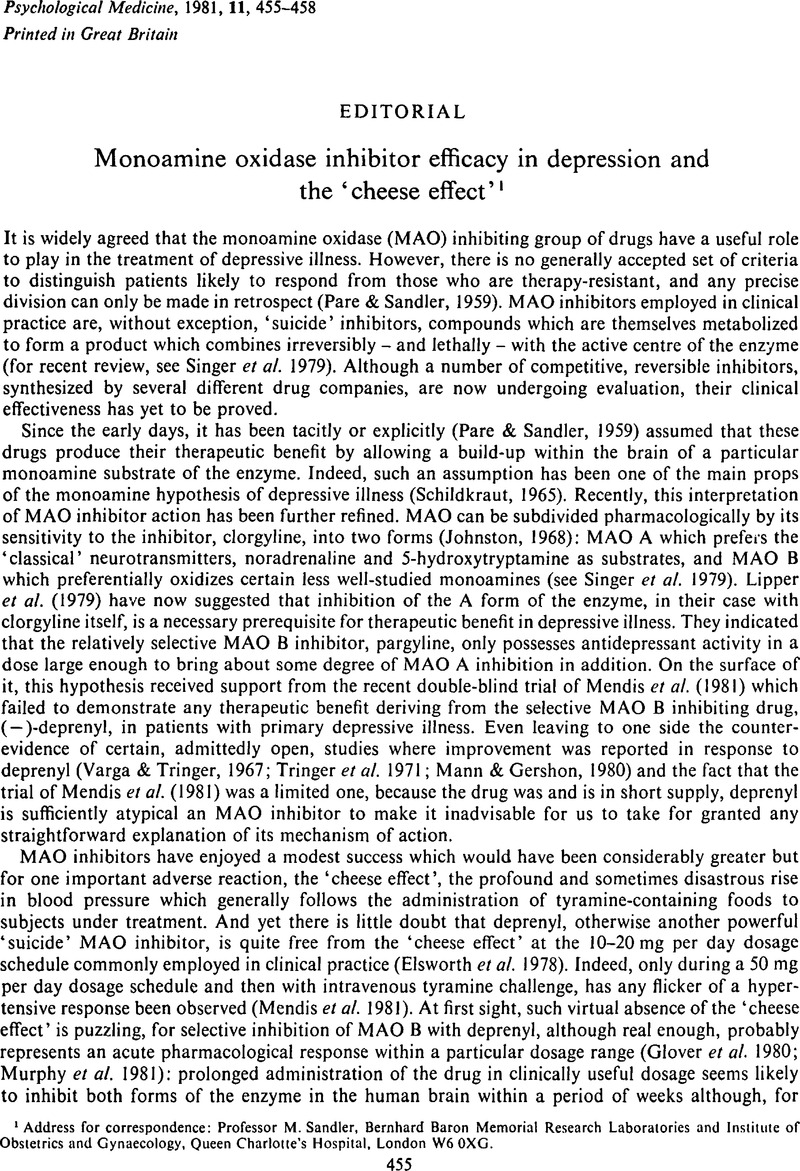Crossref Citations
This article has been cited by the following publications. This list is generated based on data provided by Crossref.
Sandler, M.
and
Stern, G.M.
1981.
Movement Disorders.
p.
166.
Tyrer, P.J.
1982.
Drugs in Psychiatric Practice.
p.
249.
SANDLER, MERTON
1983.
Monoamine oxidase inhibitors and their pharmacological significance.
Acta Neurologica Scandinavica,
Vol. 68,
Issue. ,
p.
37.
Glover, Vivette
Pycock, C.J.
and
Sandler, M.
1983.
Tyramine‐induced noradrenaline release from rat brain slices: prevention by (‐)‐deprenyl.
British Journal of Pharmacology,
Vol. 80,
Issue. 1,
p.
141.
Benedetti, Margherita Strolin
Boucher, Thierry
Carlsson, Arvid
and
Fowler, Christopher J.
1983.
Intestinal metabolism of tyramine by both forms of monoamine oxidase in the rat.
Biochemical Pharmacology,
Vol. 32,
Issue. 1,
p.
47.
PORTIN, R.
and
RINNE, U. K.
1983.
The effect of deprenyl (selegiline) on cognition and emotion in parkinsonian patients undergoing long-term levodopa treatment.
Acta Neurologica Scandinavica,
Vol. 68,
Issue. ,
p.
135.
1983.
National Library of Medicine.
Clinical Research Practices and Drug Regulatory Affairs,
Vol. 1,
Issue. 4,
p.
371.
Fowler, Christopher J.
and
Ross, Svante B.
1984.
Selective inhibitors of monoamine oxidase A and B: Biochemical, pharmacological, and clinical properties.
Medicinal Research Reviews,
Vol. 4,
Issue. 3,
p.
323.
Williams, Carvell H.
1984.
Selective inhibitors of monoamine oxidases A and B.
Biochemical Pharmacology,
Vol. 33,
Issue. 2,
p.
334.
Pare, C.M.B.
Al Mousawi, M.
Sandler, M.
and
Glover, Vivette
1985.
Attempts to attenuate the ‘cheese effect’ combined drug therapy in depressive illness.
Journal of Affective Disorders,
Vol. 9,
Issue. 2,
p.
137.
Tyrer, Peter
and
Marsden, Charles
1985.
New antidepressant drugs: Is there anything new they tell us about depression?.
Trends in Neurosciences,
Vol. 8,
Issue. ,
p.
427.
Peatfield, Richard
1986.
Headache.
p.
15.
McCabe, Beverly J.
1986.
Dietary tyramine and other pressor amines in MAOI regimens: A review.
Journal of the American Dietetic Association,
Vol. 86,
Issue. 8,
p.
1059.
Glover, Vivette
and
Sandler, Merton
1986.
Clinical chemistry of monoamine oxidase.
Cell Biochemistry and Function,
Vol. 4,
Issue. 2,
p.
89.
Tyrer, P.
and
Shawcross, C.
1988.
Monoamine oxidase inhibitors in anxiety disorders.
Journal of Psychiatric Research,
Vol. 22,
Issue. ,
p.
87.
Sandler, M.
and
Glover, V.
1989.
Drugs for the Treatment of Parkinson’s Disease.
Vol. 88,
Issue. ,
p.
411.
Magyar, K.
1993.
Inhibitors of Monoamine Oxidase B.
p.
125.
Magyar, K.
and
Szende, B.
2000.
Apoptosis and Its Modulation by Drugs.
Vol. 142,
Issue. ,
p.
457.
Carotti, Angelo
Carrieri, Antonio
Chimichi, Stefano
Boccalini, Marco
Cosimelli, Barbara
Gnerre, Carmela
Carotti, Andrea
Carrupt, Pierre-Alain
and
Testa, Bernard
2002.
Natural and synthetic geiparvarins are strong and selective MAO-B inhibitors. synthesis and SAR studies.
Bioorganic & Medicinal Chemistry Letters,
Vol. 12,
Issue. 24,
p.
3551.
Schäfer, Wiebke
Princk, Christina
Kollhorst, Bianca
and
Schink, Tania
2019.
Antidepressants and the Risk of Hemorrhagic Stroke in the Elderly: a Nested Case–Control Study.
Drug Safety,
Vol. 42,
Issue. 9,
p.
1081.



